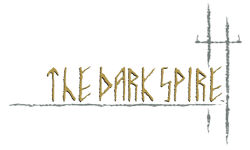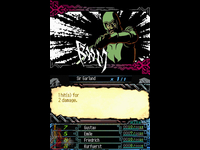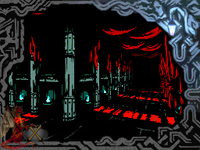|
|

|
PLATFORM
|
DS
|
BATTLE SYSTEM
|

|
INTERACTION
|

|
ORIGINALITY
|

|
STORY
|

|
MUSIC & SOUND
|

|
VISUALS
|

|
CHALLENGE
|
Very Hard
|
COMPLETION TIME
|
40-60 Hours
|
|
OVERALL

|
+ Successful attempt at recreating an 80's RPG
- You have to ask yourself just one question: Do I feel lucky? Well do you, punk?
+ Impressive audio and engrossing art
- Often obtuse with mechanics
+ Saving anywhere is a lifesaver...
- ...because dying constantly is an unavoidable part of the game
|
Click here for scoring definitions
|
|
|
Nostalgia is a powerful force in the video game industry. Developers seeking to channel the 'good old days' have a rather healthy business model. Deciding precisely what 'good old days' to emulate in the RPG world is a sensitive matter, as most modern RPGamers have no memory of the genre's roots. Success decided that the 'good old days' it wanted to relive are those of Ultima and Wizardry's early 1980's incarnations, and thus was The Dark Spire created. As an exercise in recreating a game from the era, The Dark Spire is a complete success. RPGamers who have little or no experience with this style of game will likely find its eccentricities and reliance on good luck unpleasant, however.
Dungeon exploration will take up the vast majority of playtime in The Dark Spire's eponymous central location. This dungeon takes up eight floors that will require many hours of investigation in a first-person view to unlock fully. Throughout this investigation enemies will attack randomly and frequently. The player must prevail in turn-based combat against the numerous antagonists.
The Dark Spire differs in the details from more recent RPGs in the enormous injection of luck as a factor into battle. Random turn order in battle is particularly obnoxious in this game, but that element is but the beginning of luck's integration. Invisible dice are rolled to accompany every action, in a nod to the Dungeons & Dragons roots of the RPG genre. Attacks will miss with great frequency if an invisible dice roll determines that they did not hit. These invisible dice are responsible for many other things in the game being widely ranged in effect, such as the physical and magical attack damage dealt, the hit points of otherwise identical enemies, and whether a spell actually functions correctly. The many random elements in combat mean that battles are long and messy, with the player depending upon luck to win most of the time. Skill of the player and character strength do play their roles, but luck is necessary to avoid destruction.
Experience and gold are dropped by enemies once victory is achieved. The experience, however, must be turned in to the Guild outside of the dungeon in order for level-ups to occur. No statistics other than hit points will increase with a level-up, and experience must be funneled into deliberately raising the other character attributes instead. As for the gold left behind after battle, usually it will be inside a treasure chest with nasty and plentiful traps that will cause great pain if not disarmed.
While the beginning of the game features acceptable equipment in shops, the inventory does not change much as progress into The Dark Spire is made. Acquiring better weapons and armor is contingent upon luck with drops from enemies, and the items dropped by enemies require luck to acquire without enormous pain from traps. Hearkening back to Dungeons & Dragons, armor does not actually increase defense, instead it decreases the odds of the enemy actually hitting a character when attacking. The Armor Class (AC) rating change can be seen, however figuring out how strong any weapon is requires empirical observation. One must look at the text description of a weapon to figure out whether it is any good, and even they are not completely reliable.
 No relation to another Garland from some obscure RPG series - I think.
No relation to another Garland from some obscure RPG series - I think.
|
|
At the beginning of the game, four character classes are available, each with a distinct purpose. Warriors are the physical meat shields. Thieves handle trap disarmament and the unlocking of doors mandatory to progress. Mages and priests respectively handle offensive and defensive magic. All classes save the Warrior are unable to equip the vast majority of weapons and armor or else their unique class skills will be taken away. Advanced classes are available later into the game, but accessing them is a laborious task with requirements that will never be visible to the player.
Aside from the random aspect of how much healing an item will perform, the inventory is acceptable. Its limitation to 64 total items including current equipment is a bit constraining, but not difficult to deal with. There is one quirk to using items outside of battle however: the game will not ask for a confirmation but simply use the item on the character currently selected. Until one becomes accustomed to this, many items will likely be wasted on the wrong characters.
Many things add to the difficulty of The Dark Spire, but at least the game has an automap that may be pulled up with a single button press to make its first person navigation less confounding. The game can also be saved at any time. Given the frequency of bad luck while battling enemies in this game, it is an ability useful beyond measure. Perhaps to veterans of similar titles, The Dark Spire's difficulty is not formidable. However, when the time required to complete the game is not accurately reflected on its clock because of the many hours spent dying and restarting, the game must be termed very challenging. It can theoretically be completed in around 35 hours, but to do so will require knowledge of all its passages and superhuman luck to avoid constant death.
 There is a circus of sorts, actually. No clowns though. Kramer is happy.
There is a circus of sorts, actually. No clowns though. Kramer is happy.
|
|
Each floor of The Dark Spire has a different visual characteristic, and the immersion effect is strong. The art direction for the game is also a strong point, with detailed and interesting pictures for enemies and events. The one major negative regarding the game's visuals is the lack of movement: everything is a still frame with no animation. The music is also a strong point of the game, with each floor having a different theme that is very pleasant to hear. Upper floors have an interesting wordless male vocal that at the least differentiates the game's music from other titles, and is aesthetically enjoyable to boot. At any time the game can be switched to a 'classic' mode with wireframe visuals and 8-bit sound, which makes it move at a faster clip and is interesting as a change of pace.
The Dark Spire does have a story, but its presence can be effectively ignored without difficulty. The protagonists are either taken from a list the game offers or player-generated, and are simply adventurers on a quest who do not participate in any world-spanning hi-jinks or go through any personal crises. The reason that characters have to journey through The Dark Spire is thanks to a nasty fellow named Tyrhung. He stole something precious from the King, and adventurers are being recruited to get it back. The text in the game is well-written thanks to Atlus, but the plot sequences are scant in number and impact.
To that certain subset of RPGamers who have an affinity for games like The Dark Spire, Success's game is a success. To players who prefer that the innovations in the RPG field be acknowledged by what they play, this game will be immensely unappealing. The game is enjoyable when exploring the depths of the tower, but such joy will prove fleeting when a bad invisible dice roll forces the player to reload a prior save. Stripped of nostalgic fondness, the 'good old days' prove to be a much more painful period than most present players would prefer to partake of.
Review Archives
|









